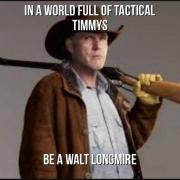
Originally Posted by
Dave J

I spent several months deployed where I had essentially unlimited ammo, but could only get to a 25m range without a lot of hassle. I didn't feel like it was holding me back much, and my 0-300 yard game improved quite a bit during this time. Even when I have access to longer ranges, I still use scaled targets quite often, especially for short practice sessions where I don't want to waste a lot of time to jogging back and forth to check targets.
I don't think there is much value to simulating targets beyond about 300, since wind and range estimation become so much more significant as you go out.
During that deployment, I made cardboard templates to replicate USPSA A-zones at 50-350, and also shot up a lot of 1" pasters. The scoring areas were offset slightly to account for my zero, and to force me to hold correctly on the "long range" targets, instead of just shooting POA/POI. For example, with my zero, my rifle would print about an inch low at 25. So I'd shoot at a black paster, and score off of a brown or beige paster stacked directly underneath it. For silhouettes that simulated 300 yds or further, I'd use a slightly raised scoring zone based on the bullet drop at the simulated distance, so I had to hold higher to hit.
One nice thing about using a vertically oriented target (like a scaled USPSA A-zone) is that the vertical column helps neglect any minor differences in your 25yd POA/POI. (talking simulated distant targets here, not close ones where you must account for sight offset.)
Most of my simulated distance work involves a timer, and getting into shooting position under time pressure, e.g. standing to kneeling, or standing to prone. I think the CSAT rifle standards are a great place to start, and lend themselves well to scaled targets. As your skill level improves, you can reduce the time standards for the "distant" targets, and tighten the scoring areas for the 25 and in, to keep things challenging.
One other point is that I think you have to be very strict with scoring scaled targets. If I'm shooting a simulated distance target, I want the bullet tip to actually hit inside the scoring zone, and not just the grease ring touching, which would equate to a miss at real distance.
FWIW, Paul Howe mentioned that he did a lot of practice on scaled targets while on contingency operations, and felt it contributed to him doing well in matches.



 Reply With Quote
Reply With Quote



